Original URL: https://www.theregister.com/2011/11/25/thanksgiving_future_guns_ii/
It's the ALL NEW FUTURISTIC WEAPONS Black Friday Roundup!
Suitcase assassin drone, electric stun rockets and more
Posted in Security, 25th November 2011 11:00 GMT
It's Thanksgiving again, the time of year when denizens of our former American colonies - alas, still in a distressingly successful and prolonged state of rebellion against their rightful sovereign - like to assemble as families and fortify themselves for a punishing day of shopping by scoffing a mountain of tuck while watching men in protective equipment running into one another on TV.
Refreshed, all true Americans then head out today and splurge any cash or credit they have left (after buying all the food) in a Black Friday bargain-binge consumer orgy. This practice, like many another, has now reached our shores in a small way. In this case we at Vulture Central are minded to surf the zeitgeist and accept something of an American theme this weekend - and, as we established last year, nothing seems to us more American in spirit than a celebration of personal weapons.
We're taking no particular stance here on whether the right to bear arms is a good thing or a bad one: nor on whether guns are more dangerous to their owners or their families than to possible domestic intruders, nor on the relative dangers attendant on having guns in the home compared to having swimming pools, patio gas, powered gardening implements, members of one's beloved extended family etc. Nor are we going to get sucked into the possibly even more acrimonious debate over just what kind of gun - in particular what kind of handgun - is best in a gunfight. (The .45ACP-vs-the-rest debate has already played out at great length in our comments pages. It seems likely that we might, again, get some people doubting that any Limey journo wiener could possibly know anything of guns or weapons, so your correspondent's death-tech CV is attached at the end of this piece.)
We're choosing to see personal shooters as an American thing partly because the USA - at least according to these guys - has the highest number of privately-owned guns per head of population in the world*. Also, of the world's major powers it is the only one whose recorded history has been played out only in the era of firearms. The other big hitters - Russia, China, Japan, the heftier European nations etc - have all seen much of their histories punctuated by the clash of steel and twang of bowstrings rather than gunshots, but America went straight from stone axes to muskets. There have been no samurai swordsmen, no knights in shining armour, no apple-shooting crossbow artists, no warrior monks or legionaries or longbowmen in US or colonial history. Rather, America has had its "minute men" with their flintlocks, its sixgun-packing western pistol fighters, its cops and robbers tooled up with Tommy guns (and even full-blown machine guns, on occasion**).
This being the Reg we generally prefer a bit of a tech angle - that is, where there are no obvious Paris Hilton implications to a story - and so it is that today we are again featuring only futuristic, unusual, high-tech weapons. You'll find no everyday lead-spitters here. Needless to say, heavy ordnance which can only be used from a fixed mount or a vehicle or which requires a crew of more than one is out too: weapons which can only be deployed by large organised groups are surely for the guvmint - the very people who might seek to pry one's trusty shooting iron from one's cold dead fingers - not for proud, freedom-loving individualists fixin' to defend their remote wilderness compounds.
Thus we have once again limited ourselves to weapons suitable for individual carry, and to make it sporting we have included only those which actually exist or genuinely appear likely to shortly. Again in the interests of fair play with our readers, this year we have a completely new line-up: none of last year's hardware is back for a repeat appearance.
So, without further ado, let's get on to the weapons.
*This is not a good guide to the percentage of Americans who are tooled up as in many cases one American will own several - or indeed, many - guns. It seems likely that a higher proportion of Swiss people have a gun in their house, for instance, as large numbers of Swiss men keep weapons at home in their role as military reservists.
**The Browning Automatic Rifle was carried by both sides in the ambush which ended the careers - and the lives - of Bonnie and Clyde. The BAR would generally be seen as a light machine-gun (or squad automatic weapon, in US parlance) being intended for use by a single person. It was used as such by US troops right up until the Korean War. One might note, though, that it fires full-fat rifle ammo, a thing which makes it seem in some ways more like a heavier general-purpose or medium machine gun. It was marketed to civilian customers between the wars as a "machine rifle", a term which may be familiar to some Reg readers from the scientifiction works of E E "Doc" Smith (for instance it appears in the Lensman books).
The Pringles-tube Robot Kamikaze Assassin Drone
So, you're an international master hit-man and there's this person you need to kill. Unfortunately, he or she is Very Important - in the head-of-state weight class - and is thus protected by extremely heavy security. Sometimes your target will make appearances on a predictable schedule: but on such occasions all rooftops within line of sight will be crawling with police counter-sniper teams, all suitable locations for a pre-positioned bomb will have been searched and sealed, and regiments of cops and bodyguards will be all over the place. Your trusty drum of home-made explosives or scope-sighted sniper rifle simply aren't going to cut it today.
Today, you need to get down to the Californian headquarters of famous crazytech firm Aerovironment, with a view to acquiring one of these:
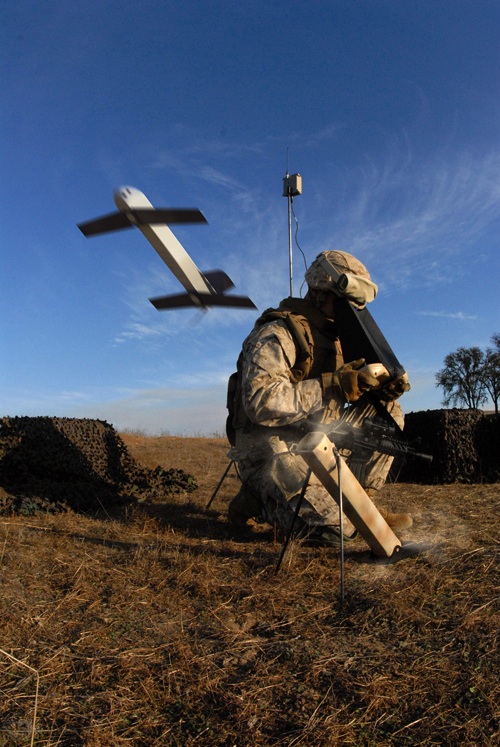
Now you can fit the CIA assassination drone fleet into a suitcase.
This little beauty is referred to by Aerovironment as the Switchblade. It was developed for the US military under the name "Project Anubis", and has variously been described as a "Tactical MAV [Micro Air Vehicle] for Time-Sensitive Fleeting Targets" or alternatively a "non-line-of-sight munition with man-in-the loop target ID with very low collateral damage".
A couple of Switchblades, stashed in their scarcely-bigger-than-a-Pringles-can launch tubes, plus controller and antenna kit, will all easily go into a backpack or a suitcase. After launch, the little aircraft can fly for up to 15 minutes on silent electric propulsion, easily enough to travel miles and get to a target location from well outside any realistic security cordon. Video from the little drone missile is relayed back to the controller (which can be at the launch site as pictured - or, with suitable comms relays, perhaps in a completely different country).
When the designated individual appears beneath, the operator selects him or her in the display and the Switchblade plummets down unerringly, detonating a small grenade or autocannon-shell sized warhead as it strikes. Anubis, guardian of the dead, has claimed another victim.
Until recently, Anubis/Switchblade was just another interesting development project: but now it is moving into operational service. Just last month, Aerovironment was pleased to announce that it had won a $4.9m contract for "rapid fielding of this capability to deployed combat forces".
Various other portable technologies of this sort - most noticeably, shoulder-fired antitank and antiaircraft missiles - have previously spread from military forces into the toolboxes of spooks and terrorists. It seems very plausible that in years to come, bodyguards and security types will have to worry about assassins packing Switchblade-type weapons, as well as the conventional menaces posed by snipers, gunmen in the crowd, bombers etc.
The Electric Shock-Rocket* Auto-Thudgun
OK, so you're not an international assassin any more. Now you're an elite police SWAT officer**. You often go into situations where you need to open fire using deadly force: but you're supposed to take them alive whenever you can, so ideally you need a non-lethal option. You also need this non-lethal option to work at longer ranges, so a regular Taser deploying its barbs on wires is out, as it can only take down someone within a few metres.
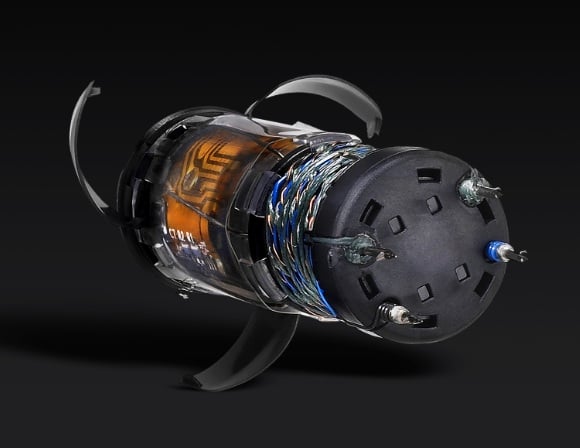
Electric stun zapbomb as used on Raoul Moat.
There is a potential solution, the Taser XREP projectile. This is designed to be shot out of a regular 12-bore shotgun. It then flies through the air, strikes its target comparatively gently for something that has come out of a shotgun, and uses its own battery to deliver a crippling zap of electric current as though from a handheld contact stungun. The XREP was famously used by British firearms officers against the rampaging gunman Raoul Moat in an apparent unsuccessful attempt to prevent him shooting himself - which later led to controversy as the XREP had not yet been formally cleared for UK police use.
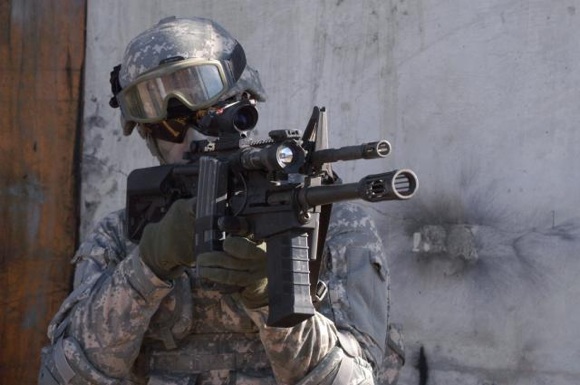
You could just load this up with electro-zap shells ...
It's possible to mount an automatic 12-bore shotgun under the barrel of a military assault rifle, in place of more commonly seen 40mm grenade launchers sometimes found under there (such launchers, deployed as an independent weapon, were formerly known as "thud guns" or "thump guns"). Such a combination, loaded with XREP zap shells in the shotgun, would offer both lethal force and a non- or less-lethal option all in one, just what you need.
But a rifle/shotgun makes for a rather heavy and cumbersome combo weapon - not one it'll be simple to point and shoot in a hurry.
But not to worry, my heavily armed law-enforcing friend. Taser International and Aussie crazy-guns firm Metal Storm have an answer for you. They've teamed up to produce an XREP electro-stun warhead mounted on a Metal Storm rocket base. Metal Storm rockets can be stacked up one on top of another in a gunbarrel: as they don't leave behind a cartridge case when fired, they can be triggered electrically one after another very quickly indeed (multibarrelled Metal Storm test weapons achieved rates of fire above a million rounds per minute in the 1990s, leading to much hype and speculation at the time).
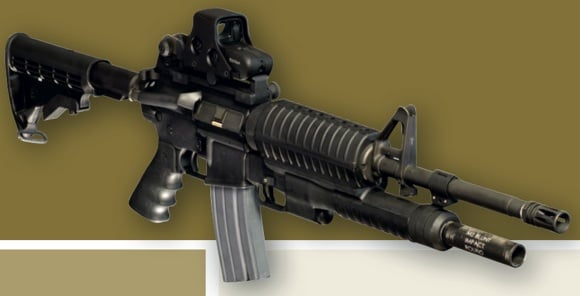
This does look less fiddly, and adds more tech madness.
The idea is that one would have a five-shot "MAUL" stun-rocket launcher mounted beneath one's assault rifle. This would be much lighter than an auto-shotgun as it needs no magazine or action, and could ripple out its superimposed rocket zapbombs as rapidly as its user might require - in a fully-automatic burst, if required, though at the cost of punishing recoil from the all-burned-on-launch rockets. Being electrically triggered, the firing switch could easily be remoted back to the rifle's trigger group where it's wanted, too, though this isn't done in the standard MAUL design.
Whether the world really needs such a thing remains to be seen, however. The advantage over a normal underbarrel shotgun might not be enough to persuade cops or troops to adopt a new type of ammunition, and the capability seems to be somewhat niche-within-a-niche to put it mildly. This is the more so when one reflects that many SWAT-cops and some soldiers generally carry shotguns into a firefight anyway, not bothering with a rifle. Then, shotgun-toting US SWAT police generally seem to favour the use of "beanbag" cosh rounds over any form of Taser, perhaps because of the negative publicity that generally follows any use of electroshock weapons.
But the XREP MAUL will at least be developed, even if it never sees widespread use: it is a real thing, not just a gleam in a weapons maker's eye. And as a by-god electric rocket shockbomb auto-thudgun, it's definitely worthy of a place on our mad futuristic weapons list.
*Shocket™?
**Or for British readers, a Specialist Firearms Officer; or for some eastern US readers, an Emergency Services copper as opposed to SWAT. The New York Police Department's Emergency Services Unit acts as the city's SWAT squad and does many other things besides.
The Hollywood style machine-rifle that can fire for ages on full auto without reloading or melting its barrel
Change time again. You're not a SWAT door-kicker any more, but an infantryman of the (perhaps quite near) future. You carry a weapon - it's called a "machine rifle", perhaps - which is no heavier than a normal assault rifle of today. But, amazingly, you can fire long bursts on full auto as though you were in a movie without stripping all the rifling out of the bore: and then fire more long bursts without reloading, because your weapon holds easily fifty or a hundred rounds, while remaining light enough to handle easily in a close-up firefight. When it does finally run empty, no need to fret - you snap in another massive box of rounds. They're light enough that you can carry plenty.
How is this possible?
Well, it's the result of a couple of new technologies that US military boffins have successfully tested in the past year, both initially aimed at easing the life of machine gunners within infantry sections*.
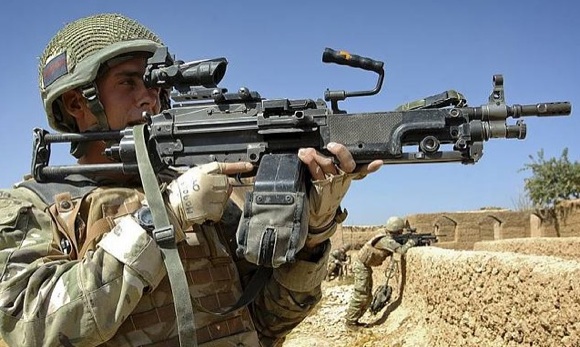
The Light Machine Gun. Only light in the context of machine-guns, though.
At the moment in most modern armies, one soldier in each four-man fire team carries a light machine-gun (aka Squad Automatic Weapon in some circles). As he has to hump his gun and most of his ammo himself, it certainly doesn't have a cooling water jacket around its barrel in the style of former days. Nonetheless, he's expected to fire it on full automatic as a matter of routine, if not perhaps with the gay abandon seen in the movies. It's the gunner's job in a firefight to put continuous firepower on the enemy, so keeping him pinned with his head down and allowing the gunner's team-mates to manoeuvre and win the fight (that's the theory, anyway).
The only problem is that even firing professional, short, controlled bursts, one will quite soon heat up your gun's barrel to the point where it will start to melt and become useless. Thus, modern machine guns are generally designed so that the barrel can be swiftly swapped for a spare. The gunner can thus keep on shooting while the first barrel gets a chance to cool off.
Unfortunately this means that a gunner or one of his mates has to lug around a spare barrel on top of all the other gear festooning the section: and steel gunbarrels, especially ones meant to stand up to sustained automatic fire, are heavy things.
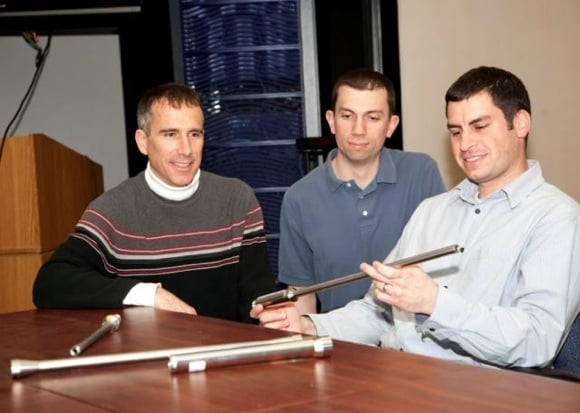
Well that's the Hollywood gun-barrel cracked, lads. Now we just need to sort out the Hollywood mags.
US military boffins have been working on this problem for a while, though, and they think they have an answer. They want to make gun barrels out of cobalt alloy rather than steel, because cobalt is largely proof against heat and would also allow for less weight.
A cobalt-barrelled gun really could fire high-powered ammo on full automatic with the same profligacy as you see in the movies, without suffering any barrel-melting issues (although if nothing else changed, people would still struggle to carry the amount of ammo that movie protagonists often get through).
The snag with cobalt, however, is that being so tough it's very difficult to form. In particular it's very difficult to put the spiral rifling grooves down the inside of the barrel, necessary to make the bullets spin and so fly straight. Normally the rifling is cut into the bore, but this is impractical with super-tough cobalt.
However, US Army and Navy engineers (the latter interested in equipping their Marines and SEAL frogman-commandos better) believe they've cracked this. They've come up with a technique in which a cobalt tube has a hard preformed mandrel inserted into it. The tube is them compressed onto the mandrel extremely hard using rollers, causing its interior to take on the mandrel's shape. The rifling is pressed into the bore, rather than being cut.
This "flow forming" method has been used to make a gunbarrel from 50+ per cent cobalt alloy. The engineers then test-fired 24,000 rounds through it, causing it to reach temperatures of 1,100 degrees. A steel barrel would have failed under such treatment.
Military boffins at the famous Picatinny Arsenal are enthusiastic about the new technology, and expect to produce a cobalt barrel for an in-service machine gun by the end of the year. The cobalt barrelled gun, able to fire Hollywood-style long bursts without wrecking itself, is about to become reality.
But that's not all. The US Army has also recently announced successful tests of a new, lightweight portable machine-gun which fires special plastic ammunition. The gun and ammo are so much lighter than current weapons and their brass-cased cartridges that some soldiers are suggesting that every infantryman could in future pack the sort of firepower reserved today for heavy-weapons specialists.
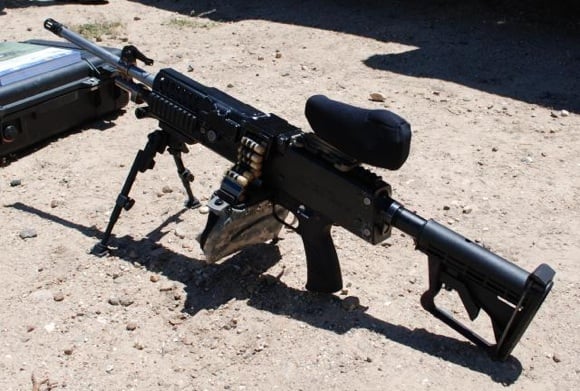
The machine-gun that only weighs as much as a rifle.
"I could see a whole squad carrying it," said Specialist Brandon Smith of the US Army, having participated in the trials lately, meaning that all soldiers would have such firepower in their personal weapons, not just specialists. "You would own the battlefield."
A regular light machine-gun shoots the same ammunition as the other troops' rifles, but it is normally fed from a long belt rather than a magazine with only 30 rounds, and an LMG is designed to be fired on full auto for sustained periods (though in short bursts only, or even its heavy barrel would soon fail due to overheating).
The downside of this is that the machine-gun and its belt (nowadays generally packaged in a box fitted to the gun, to prevent it flapping about and being a pain) are heavy, so much so that the gunner is at a decided disadvantage in a close-up gunfight where he needs to aim and shoot quickly while standing up. And the total load of weapon plus lots of ammo is very heavy.
Thus most soldiers are armed with assault rifles not built to deliver sustained automatic fire and holding less ammo. These lighter weapons are handier for close-in fighting and permit other kit to be carried.
But US military boffins at the famous Picatinny Arsenal have also been working on this situation for some time. Since ammo weight and bulk is much of the problem, they have come up with a new kind of ammunition: Cased Telescoped cartridges.
In a cased telescoped round, the bullet is no longer attached to the tip of a brass case full of propellant powder. The new case is shorter, fatter and made of plastic, so weighing substantially less, and the bullet is sunk into the middle of the propellant which makes the whole round shorter - it has been "telescoped". A shorter round weighs less itself, and also means that the gun's action, feed equipment etc is smaller and thus lighter as well. It's a trick originally developed for tanks, to make the turret smaller and easier to protect.
According to the Picatinny scientists, their new LMG and a thousand rounds of its plastic-cased-telescoped ammo weigh fully 20.4 pounds less than the current M249 (a version of which is also used by British troops) and a thousand ordinary 5.56mm brass cartridges. The new LMG shaves no less than 8.3 pounds off the 15.7-lb M249, coming in at just 7.4lb - actually lighter than a standard British SA80 assault rifle! This, perhaps, explains Specialist Smith's opinion that it would be reasonable for all soldiers to carry such weapons, rather than just heavy-weapons specialists.
There are other advantages: the new LMG's novel rotating chamber doesn't heat up as an M249's does, and plastic cases are more heatproof than brass ones, thus reducing or eliminating the issue of "cook off". This is where a round is chambered and then goes off immediately due to the chamber being hot from prolonged firing, regardless of whether the trigger is depressed at the time.
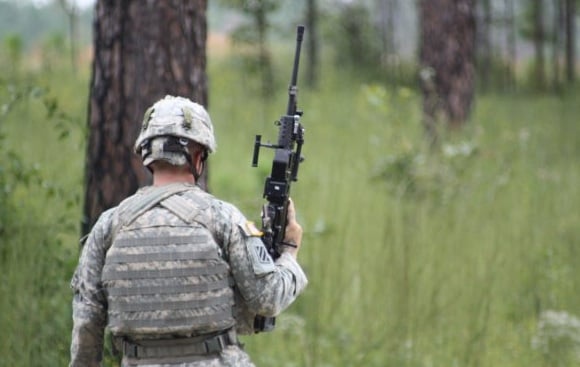
Certainly this bloke isn't finding it too heavy.
So all that's necessary now is to fit the new plastic-case-telescoped LMG with a cobalt barrel - making it even lighter - and there it is at last: a gun weighing no more than an assault rifle which hold a whole belt-full of ammo and can fire the whole lot off on full auto if you want without blowing the lands out of the bore. Truly, it would seem that the man-carried automatic weapon as envisaged by Hollywood has arrived at last. And "machine rifle" (see the footnote on the first page of this piece) would seem like the proper name for it.
*Squads, in American units.
The Shoulder-fired Homing Sniper Missile
OK, you're back being a master hitman again. You want to pick off an individual target at very long range. You could use the Switchblade/Anubis that we looked at earlier, but there's a problem in this case: the other side have competent electronic-warfare specialists, and a continuous video link to the drone munition is a big no-no. These people might not just jam it, they're so good they might conceivably get a location on the firing point as soon as you switch on and shoot first. (Though they might be cheesed off about pay and not on the top of their game.)
No, you need to stay totally radio-silent here: transmissions from your equipment are out. To make it a bit easier, this time you do have line-of-sight to your target, but the old sniper rifle just isn't going to do it today. You have line of sight, yes, but you're viewing the area from a skyscraper several kilometres away and when your target appears he or she will be moving and you'll only have time for one shot.
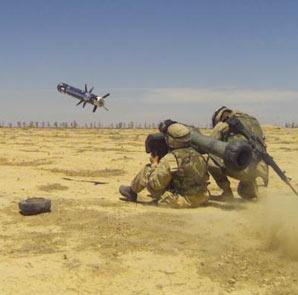
OK Mr Sniper, suck on this.
Perhaps one day, if Pentagon crazytech agency DARPA ever manages to perfect the guided .50 smart-bullet as it is trying to do, you might manage this sort of job using a heavy cal-fifty sniper rifle. But in fact it might be managed today, up to 2.5 km or so anyway, using a shoulder-fired Javelin missile. This was actually developed as an anti-tank weapon, but British forces fighting in Iraq and Afghanistan have frequently used it to take out individual snipers or small groups such as machine-gun crews - so much so that the British Army had to expensively purchase extra stocks.
But the Javelin is fat and heavy: it is only marginally portable and useable by a single man, and usually has a crew of two, so it isn't really suitable for our line-up here. Furthermore it doesn't have enough range for our task today.
But there is something much more suitable on offer nowadays. As regular readers will recall, US Navy boffins have lately added a cunning "fire-and-forget" homing seeker like the Javelin's to much slimmer and lighter 70mm rockets, which weigh just 6kg as opposed to 12kg. The naval brainboxes are looking to shoot these at multiple targets from helicopter pods holding many rockets, but in this context it's intriguing to note that the Norwegian arms industry has recently offered (pdf, see page 140) a tripod mounted, portable single-shot 70mm launcher modified to home on a laser dot, for special forces use.
An offering similar to the Norwegians', but fitted with the new US Navy LCITS fire-and-forget homing seeker instead, would offer the same capabilities as a Javelin but with much more range, much less cost and much less overkill on the warhead - indeed the option would probably be there not to use an explosive warhead at all and simply let the projectile drill a 70mm hole in its target as in the Office of Naval Research vid above. And the package of launcher tube and command unit would be much lighter-weight than a Javelin to boot, truly portable for a single person.
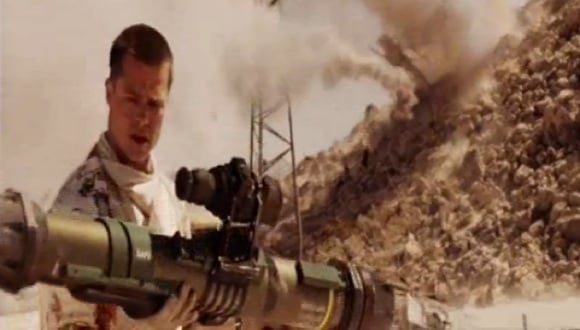
Something a bit less punchy might have been more the go.
We might not see such things being used to settle marital disputes - Brad Pitt seemed to be favouring the heftier Javelin-style option for use on a troublesome Angelina Jolie in Mr and Mrs Smith - but there can't be much doubt that the weapons industry could nowadays quite easily assemble a light, slender, fire-and-forget passive homing sniper missile with a useful range well over 5km. Such a thing could surely be sold without condemnation to ground troops in Afghanistan, even if not to international hitmen or assassins.
The Silent, Armour Piercing Spec-Ops Rifle
This one's not exactly futuristic - it's a technology development that happened quietly in the 1990s, and could have (maybe did) get implemented a lot earlier than that. But we here on the Reg crazy-guns desk think it's an interesting development in ballistics, and there's an angle into super-secret special forces units, so it's made our list today.
Your final viewpoint job change gives you a tricky task. You're no longer a hitman as such, but rather a super-elite special forces operative tasked to make a stealthy surprise attack on something pretty tasty: rogue-nation presidential palace compound, secret nuclear-weapons plant, evil billionaire's superyacht, something like that.
Unfortunately the opposition have a sentry posted in your path and you can't get within striking distance of the objective without taking him out. You need to drop him silently, though, to avoid tipping off his chums and sounding the alarm.
Sneaking up on him with a view to employing knife, garrotte or little-known Oriental furtling technique is a bit old-fashioned, and anyway the lay of the land is such that it won't work: you can't get near him unseen. Normally you'd simply reach for your silenced pistol or submachinegun, but you're out of luck here on two counts.
First, you simply can't get close enough without being spotted. The low-velocity pistol slugs from your silenced Heckler & Koch MP5SD-N1 (often the choice of the discerning direct-action operative) just aren't accurate enough at this sort of distance.
Second, these villains are well-equipped and the sentry you need to knock off is wearing decent body armour and a helmet. Slow and comparatively fat pistol slugs wouldn't penetrate his protection even if you could get close enough to hit him with them.
The normal solution to problems of short range and poor armour penetration is to use a proper rifle firing intermediate- or high-powered ammunition, as opposed to a submachinegun firing low-power pistol rounds. You can in fact fit a suppressor to the business end of a rifle, squelching the sound of the actual muzzle blast to the point where it won't be very noticeable at a distance (and won't be very recognisable even if it is heard). Unfortunately the bullet will still be travelling at supersonic speed, generating a miniature sonic boom rather as the tip of a whip can. As anyone who's been shot at - or been in a butt party* - can testify, the supersonic crack of rifle bullets passing nearby can be as loud as or louder than the noise of the gun itself going off.
You can always reduce the powder charge in the rifle cartridges to slow the bullets down to subsonic speed, but this robs them of their range and penetrating power, rendering them little better than pistol rounds.
It's a puzzler.
In recent times, however, American gun-fanciers have come up with a solution. As any fule kno, a bullet's kinetic energy is calculated by the formula ½ x mass x velocity2. If velocity must be cut down to below the speed of sound, one can compensate and restore energy by increasing the slug's mass. Provided that one does so by making the bullet longer rather than fatter, the energy will still be delivered onto the same cross-sectional area and (all other things being equal) the same penetrating power should be achieved.
This has led to so-called "Whisper" cartridges, generally featuring a long, heavy bullet and with a powder charge loaded to achieve a muzzle velocity just below the speed of sound. The well-known Whisper .300 delivers as much energy as a fat .45 pistol bullet, but onto an area less than half the size for much better penetration - and at much greater range. It can be fired through an integrated silencer from a suitably configured AR-15 automatic rifle**, and rumour has it that a shorter submachinegun- or carbine-style weapon has also been produced for it, presumably intended for US special-forces units or similar customers. The famous British sniper-rifle maker Accuracy International offers something along these lines also: a suppressed rifle firing .308 subsonic ammo which it says is accurate to 200 yards. Given AI's past history, one can reasonably expect that this weapon is in the armoury of Britain's 'Tier One' special ops direct-action units, the SAS and SBS***.
If these slugs won't do the job, the .510 Whisper probably will. This very heavy bullet, again shot from a silenced rifle just below the speed of sound, is apparently accurate to no less than 600 yards.
According to makers SSK, Whisper rounds and weapons for them have been purchased by "numerous governmental agencies, military units and police departments". In the case of the police the Whisper ammo is presumably being bought for its virtues in avoiding "overpenetration" - where fast supersonic slugs pass through the things they were aimed at and fly on to cause unintended consequences further away - rather than its usefulness in silent assassination.
Silencers don't, of course, make guns silent. But they do reduce muzzle blast noise very significantly - bolt action .308 suppressed rifles along the lines of the SAS weapon mentioned above are claimed by some to be quieter than an airgun, very hard to hear at any distance. America being America, these guns are quite popular with civilian enthusiasts there, as well as secretive military units. It's quite legal for ordinary citizens to own silenced weapons (and fully automatic ones) in large parts of the USA, though it involves a fair bit of pesky federal paperwork.
So it would seem that your problems as a secret super-trooper have been solved: shooting quietly from hundreds of yards away with silent bullets that make no "crack" as they pass, you can still drop that armour-clad presidential guardsman or evil billionaire's henchman without being noticed. That's a pretty crazy weapon, even if something very like it could probably have been designed at almost any point in the last century or even before.
And with that we're done with the Thanksgiving futuro-weapon roundup for another year. Enjoy your weekend. ®
Bootnotes
Lewis Page weaponry CV:
I had to stay qualified on the SA80 5.56mm rifle and the Browning 9mm pistol for most of my 11-year service career, and latterly as 2ic or boss I would shoot more than strictly required as I liked it and nobody could stop me. I used to be in the revolver and pistol club at university, mainly shooting .22 target weapons, back when that was legal (the club mainly shoots air pistol nowadays I believe). I have occasionally fired other things such as the Lee Enfield .303, 12-bore shotguns a couple of times, 7.62mm GPMG during Commando training, the H&K MP5 submachinegun and Sig Sauer 9mm pistol on the SBS ranges at Poole (during a visit only!), airguns when a lad, an acquaintance's .45 during a trip to the States etc. Not much shooting compared to some Reg readers, and I've never been in a firefight, but I'm not totally ignorant.
As an Explosive Ordnance Disposal operator I also had to learn about the inner workings of just about anything that goes bang. So while I've never personally fired any guided missiles, rockets, mines, artillery shells (well, I did fire a 30mm cannon once), phosphorus flares, aircraft bombs, torpedoes, chemical weapons etc, I have detonated, low-ordered or otherwise dealt with literally hundreds of such things and I do know a fair bit about them and their effects.
*Not as exciting as it might sound to some: It just means working in a trench handling the targets at the end of a rifle range. The bullets from the people who are shooting pass over your head.
**The AR-15 is much better known under the names of its most common variants, the M16 rifles and M4 carbines carried by most US troops ever since the Vietnam War. The basic design is often used for making custom weapons as it was intended from the outset to be easily modified for different barrels and ammo types.
***Everyone knows about the Special Air Service, but not everyone knows the Special Boat Service (formerly Special Boat Squadron, even more formerly the Special Boat Sections). SBS operators are usually (though not always) drawn from the Royal Marines rather than the Army, and the unit was formerly naval rather than military like the SAS (both are now removed from the supervision of the army and navy heads and belong to the Directorate of Special Forces). Wouldbe SBS swimmer-canoeists undergo the same selection and initial training process as SAS troopers, and then learn diving and other maritime special-ops techniques before going operational. The SBS has a special focus on maritime operations, but in recent years has been fighting mainly in landlocked Afghanistan. Until lately the SAS would operate primarily in Iraq alongside US forces, leaving the UK's Afghanistan special ops contribution largely to the SBS, but this division of responsibility is now believed to have changed.